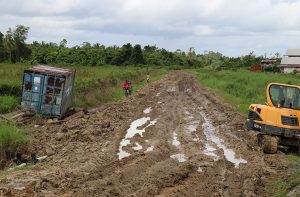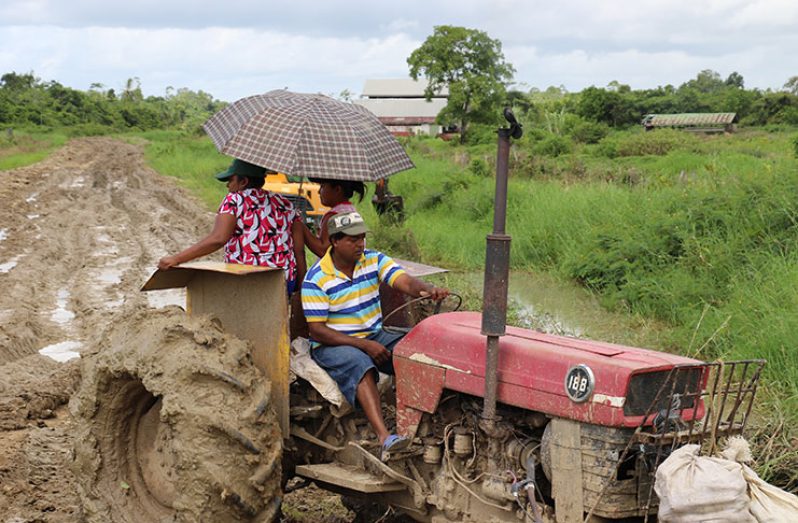WHEN Emelda Degois went into labour, getting to the hospital proved to be a startling experience, as she was forced to traverse the dam which led from her house in Moleson Creek, to the main road on foot, due to the deplorable state of the road which made it impossible for vehicles to access. Recounting her experience, Degois said that with severe contractions, in a place where electricity is absent, she, in company of her husband, walked through deep muddy tractor-wheel pot holes for over a mile before getting to a place where she could catch a taxi.
At a cost of GY$1,000, she was taken to the New Amsterdam Hospital, miles away, where she safely gave birth to her last son. And this, Degois told the Guyana Chronicle, was the same experience she endured every time she went into labour with her other children. But more than just during this fragile period, Degois and her family has had to face this turmoil every day for as long as they have lived in that area. “You cannot avoid walking in that slush,” she lamented.
It is the same dam that her children walk twice daily to get to the point of catching the David Granger ‘3B’ bus which takes them to and from school – from Moleson Creek to Crabwood Creek, Corentyne. Just months prior, residents in the area were also burdened with a lack of potable water, but this situation has since been remedied following the commissioning of the water distribution network by the Guyana Water Incorporated (GWI), a project initiated by Minister of Social Protection Amna Ally. “We feel nice about the water that we are now getting. Seventeen years we live here and was bear punishment…but we are not happy yet with the road…In the morning time [our children] go to school their ordinary clothes. When they reach to the front here they have to bathe and put on their clothes to go school,” she said.

Degois, a farmer along with her husband Gazi Munir Ibrahim, said the state of the road has her travelling out of Moleson Creek once monthly, and the rest of her days are confined to home and the farm. “I buy my ration and then when I am finished I don’t come back until another month again. Is just like if we’re living in ‘the Bush’…” she said. What she calls “living ordinary” is a life many would run from. She said that after children leave for school, she goes into the backdam to farm and does not return until about 15:00hrs when her children return home.
The predominantly East Indian community is filled with farmers. Another man, Anand Singh, who owns a cane field and a provision farm is counting daily expenses at the cost of a horribly damaged mud dam. He lives in an area where access to modern amenities and social services is easier, but travels to his farm every day. His farm employs over 40 men. An abandoned school and the state of the roads have caused several of his staff to migrate out of Moleson Creek and more of them are following.
“When you supposed to work seven to four you meet there 11 o’clock, so four hours gone in travelling time. And you are carrying 30 to 40 persons, so 30 persons, 40 persons lose four hours… and then when you come out again 4 o’clock you meet till 8-9 o’clock in the night. Then the workers them meet late in the morning because it involves a whole day to do four hours’ work,” Singh told the media.
The reason the dam has gotten to the state it is in is because the area accommodates large scale farming which includes thousands of acres dedicated to cane, rice, vegetable citrus and other types of farming. Singh said the area was developed specifically for sugar cane harvesting to supply the new factory nearby, with some 7000 acres of cultivated sugar cane land, harvested annually. “We harvest two crops a year from March to the end of April and from August to December. We will lose some purity of the cane, we will lose some like ten to fifteen percent. Cane is a very sturdy grass. It withstands weather… you will not get the maximum output that you could have but you will get in essence of about 80 percent,” he said.
But what the community needs most is an asphalt road. “We need a road, one major road. This place employs over 250 persons permanently. We have in excess of 30 homes, and more people are moving out because of the dam… We can get much more. We get a lot of farms. We get citrus farms, cane farms, provision farmers, and rice farms. The place has full potential. In the dry weather people go back again because the land is very fertile and it gives you a lot of bountiful harvest. So although people are impeded by the dam, if you get a good access there, people will take full advantage there because the land is very fertile. And we have good drainage system. We have three sluices in here. The government made three sluices for us and we get good drainage,” Singh concluded.




.png)









